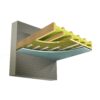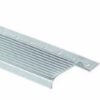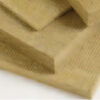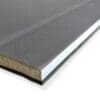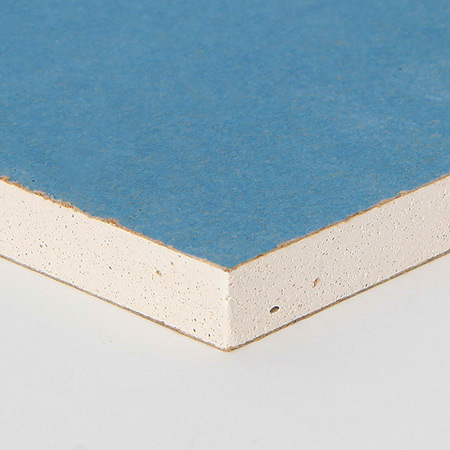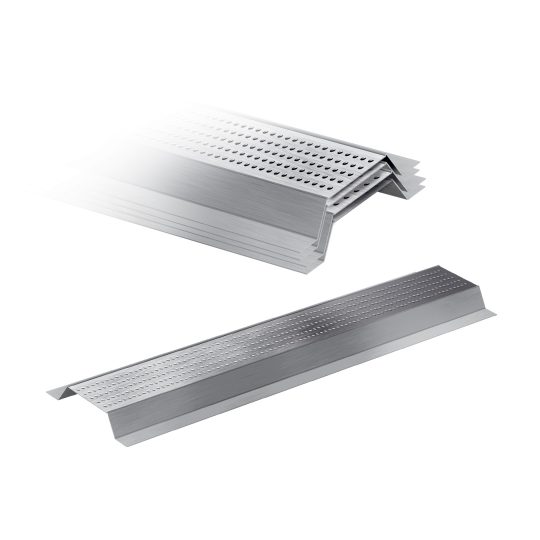Description
Ceiling System 1
Ceiling system 1 has ben designed for soundproofing ceilings with maximum noise reduction and minimum space loss. It is a high-performing ceiling soundproofing solution that offers excellent airborne and impact sound reduction with only 85mm of ceiling height loss. Ceiling system 1 achieves high levels of noise reduction due to the combination of materials and how they are installed onto the ceiling. The system combines two layers of insulation to increase airborne sound reduction.
The separation, key to ceiling soundproofing, is created by fitting the soundbreaker bars that reduce vibration through the building’s structure.
The final layer of boards is applied directly into the soundbreaker bars. The Noisestop 1+ panels supplied as part of this solution combine a 12.5mm acoustic plasterboard and a 10kg mass vinyl sheet. The resultant panel blocks sound and reduces vibration through the plasterboard.
- Noise reduction against airborne and impact sound
- 60dB airborne sound
- 5dB impact sound
- 30-minute fire protection
- DIY ceiling soundproofing solution
- Part E compliant for separating floors
With a good understanding of DIY, you can install this complete ceiling soundproofing solution yourself. We’ve created a guide to take you through the installation process step-by-step, and you’re always welcome to get in touch with our knowledgeable team with any questions you have.
We have put these soundproofing systems together as examples of combinations of products you can use to soundproof a room. You can use various combinations to suit your requirements, whether you are looking for additional sound control or you might have a bit of extra space for a thicker solution.
Ceiling System 1 Features
- DFM acoustic insulation – 100mm DFM acoustic insulation and a 50mm DFM acoustic insulation layer to block and absorb airborne sound transfer through the ceiling.
- Soundbreaker Bars – The separation, which is key to ceiling soundproofing, is created by fitting the soundbreaker bars acoustic hangers that reduce vibration through the structure of the building. The final layer of boards is applied directly to the soundbreaker bars.
- Noisestop 1+ panels – Supplied as part of this solution, Noisestop 1+ Panels combine a 12.5mm acoustic plasterboard and a 10kg mass-loaded vinyl sheet. The resultant panel blocks sound and reduces vibration through the plasterboard. Both impact and airborne sound are significantly reduced when the entire solution is combined.
- AC50 acoustic sealants – Apply AC50 acoustic sealant to the edges of the panels and the perimeter of the new ceiling.
Ceiling System 1 Products
Combining soundproofing materials to create a soundproofing system is the best way to soundproof a room. Take a look at the individual components supplied when you buy Ceiling System 1.
| Area m2 | DFM 100mm/60kg (2.88sqm per pack) | DFM 50mm/60kg (5.76sqm per pack) | Soundbreaker bars 3m | Noisestop 1+ Panel 18mm | AC50 acoustic sealants (standard size) |
| 5 | 2 | 1 | 8 | 4 | 2 |
| 6 | 3 | 2 | 9 | 5 | 2 |
| 7 | 3 | 2 | 11 | 6 | 2 |
| 8 | 3 | 2 | 12 | 7 | 2 |
| 9 | 4 | 2 | 14 | 7 | 2 |
| 10 | 4 | 2 | 15 | 8 | 3 |
| 11 | 4 | 2 | 17 | 8 | 3 |
| 12 | 5 | 3 | 18 | 9 | 3 |
| 13 | 5 | 3 | 20 | 10 | 3 |
| 14 | 5 | 3 | 21 | 10 | 3 |
| 15 | 6 | 3 | 23 | 11 | 3 |
| 16 | 6 | 3 | 24 | 12 | 4 |
| 17 | 6 | 3 | 26 | 12 | 4 |
| 18 | 7 | 4 | 27 | 13 | 4 |
| 19 | 7 | 4 | 29 | 14 | 4 |
| 20 | 7 | 4 | 30 | 14 | 4 |
-
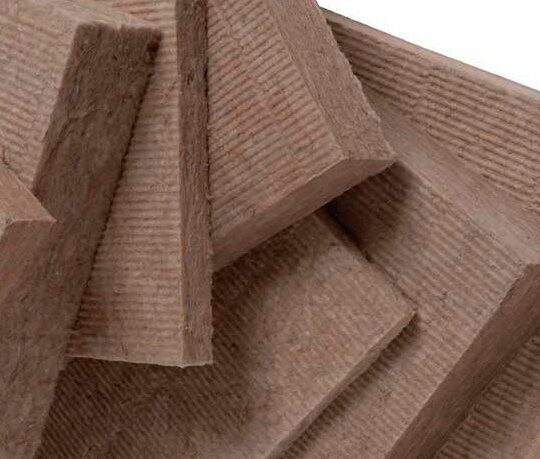
Acoustic Insulation 100mm DFM Per Pack
£41.00 – £49.00 ex. VAT
-

Noisestop 1 Plus Panel 18mm x 1200mm x 1200mm
£29.95 ex. VAT
-

Acoustic Insulation 50mm DFM Per Pack
£44.00 – £52.00 ex. VAT
-

AC50 Acoustic Sealant 380ml & 900ml
£3.95 – £7.25 ex. VAT
-
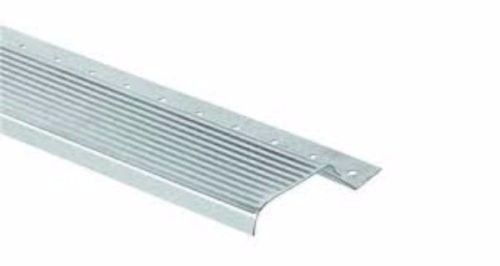
Soundbreaker Bar Acoustic Hanger 3m
£4.95 ex. VAT
Fitting Ceiling System 1
- If you are soundproofing existing ceilings, you will have to remove them before fitting ceiling system 1.
- Infill the joist cavity with 100mm acoustic insulation. Ensure the whole area is filled. Acoustic insulation slabs will friction fit between the joist if you cut them wider than the opening.
- Attach an additional timber batten perpendicular to the joist and fill with the 50mm acoustic insulation slabs.
- Fit the soundbreaker bars at 400mm centres. The soundbreaker bars are attached to the timber battens by screwing through the pre-drilled holes.
- Attach the Noisestop 1+ panels to the bars by screwing through the boards into the wide corrugated flange on the soundbreaker bar.
- Use the acoustic sealant to seal the edges of the panels and around the perimeter of the ceiling.
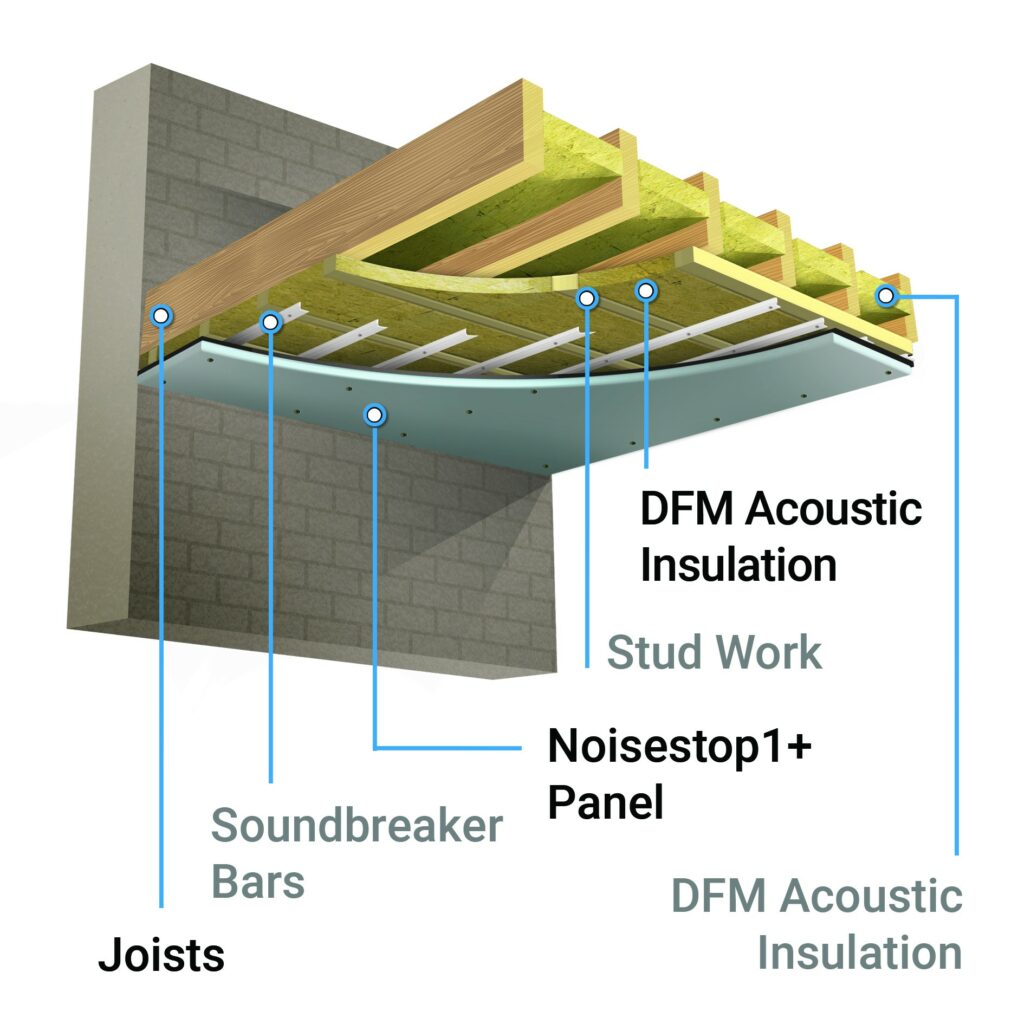
- Install onto existing or new ceilings
- The system’s thickness from the ceiling joist is 35mm
- 60dB airborne sound
- 57dB impact sound
- 30-minute fire rating
- A competent DIYer can carry out the installation
Alternative Solutions
Alternative solutions that will offer different levels of soundproofing or another kind of installation method that might suit your requirements.
-

Ceiling System 2 Soundproof Kit
£245.11 – £855.25 ex. VAT
-

AcoustiClip Timber Ceiling System Soundproof Kit
£370.42 – £1,293.73 ex. VAT
-
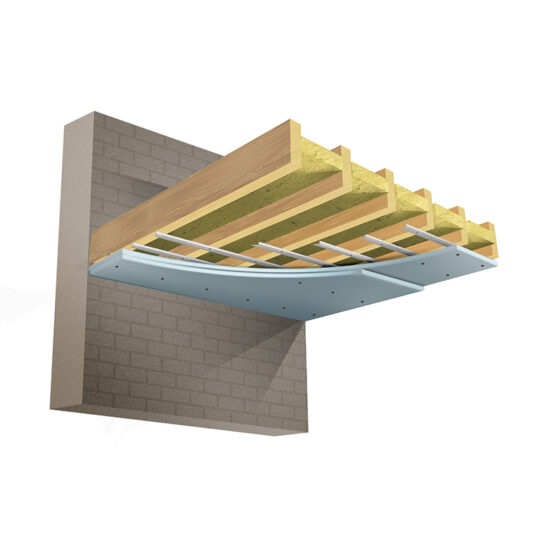
Part E Ceiling Kit
£669.33 – £1,711.86 ex. VAT
Wall and Ceiling Soundproofing
Make sure you are getting the right soundproofing for your needs. Understanding the most common types of noise and how to stop them will help you decide the right solution.
Different Types of Sound
- Airborne sounds – Conversation, TV noise and radios are examples of airborne sound. The best way to stop airborne sounds is to add mass/density to the walls or ceilings.
- Impact/vibration sounds – Footfall and moving furniture across a floor are examples of impact sounds. The best way to reduce these sounds is to create separation.
In summary, the best way to reduce airborne sounds is by increasing the mass of the area you would like to soundproof. Reducing impact/vibration sounds is achieved by creating separation within the structure.
Reducing Impact and Airborne Sounds
By following some of these steps, you will ensure you get the best level of soundproofing for your room.
- Mass/Density – Increasing the mass and density of the area you are soundproofing will block airborne sounds from transferring between rooms. You will increase the mass of walls and ceilings using materials such as soundproof panels or high-density acoustic insulation slabs.
- Separation – Incorporating separation within the structure will reduce vibration and impact sounds transferring between rooms. Achieve separation by building independent stud walls and ceilings. If you don’t have the space in the room, you can use acoustic clips and resilient channels to decouple the wall and ceiling.
- Absorption – Use materials that are going to absorb sounds. Acoustic insulation is suitable for sound absorption as it converts the sound waves into heat as it passes through the insulation. Dense mass loaded barriers will also dampen and absorb sound.



